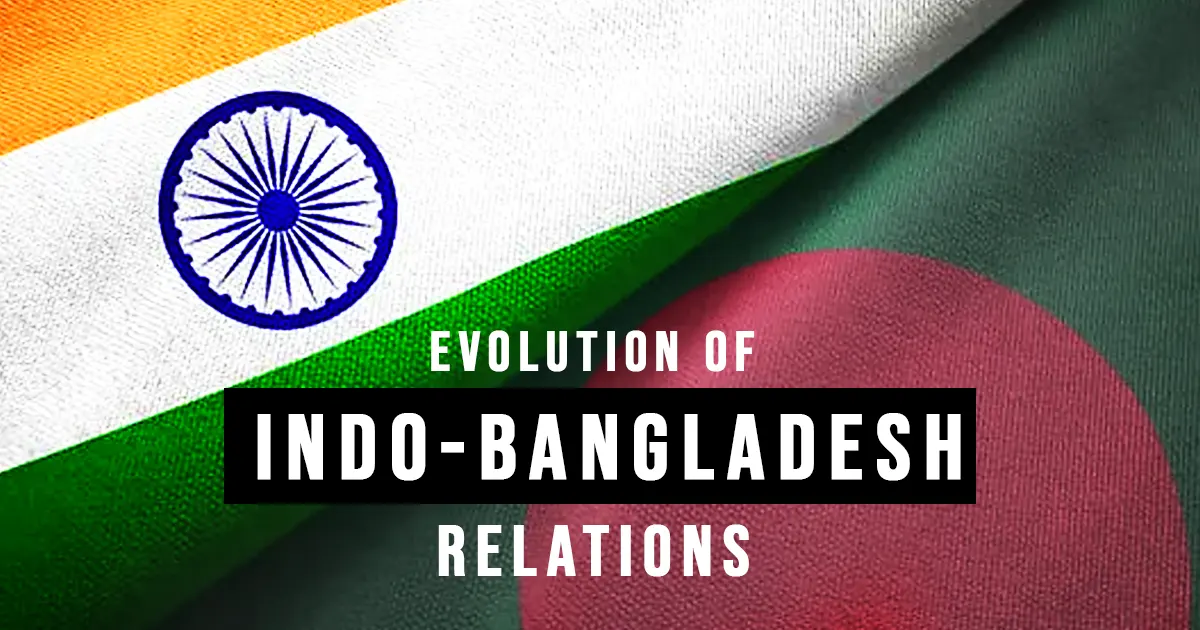GS 2 – International Relation

India and Bangladesh share deep-rooted ties stemming from cultural, linguistic, and historical connections. These bonds were solidified during significant historical events such as the Partition of India in 1947, which caused widespread suffering and separation of families.
India played a pivotal role in Bangladesh’s Liberation War of 1971, leading to its independence. India was the first nation to recognize Bangladesh as a sovereign state. The shared sacrifices of this period are commemorated annually on December 16th, observed in India as Vijay Diwas.
Over time, the bilateral relationship has evolved into what Indian leaders have referred to as a “Sonali Adhyay” (golden phase), highlighting the strengthened partnership.
Significance of Bangladesh to India
Geopolitical Importance:
Bangladesh, sharing extensive land, riverine, and maritime borders with India, is crucial for regional security and countering Chinese influence (e.g., through the ‘String of Pearls’ strategy).
Economic Ties:
-
- India is one of Bangladesh’s top trading partners, with bilateral trade reaching $18.2 billion in 2021-22.
- Bangladesh is also a vital market for Indian goods.
Cultural Linkages:
Shared history and heritage create strong people-to-people ties. Many Indian-origin people reside in Bangladesh.
Strategic Location:
Situated at the intersection of South and Southeast Asia, Bangladesh is key to India’s Act East Policy, which seeks stronger ties with Southeast Asia.
Environmental Cooperation:
Shared rivers and ecosystems, such as the Sundarbans, necessitate joint efforts in water management, flood control, and conservation.
Areas of Cooperation
Economic and Trade:
-
- Bangladesh is India’s largest trading partner in South Asia.
- Trade infrastructure like border haats and initiatives under the Comprehensive Economic Partnership Agreement (CEPA) strengthen economic ties.
Connectivity:
-
- Restoration of pre-1965 rail links, such as the Chilahati-Haldibari connection, enhances transport and trade.
- Passenger services like Maitree and Bandhan Express foster people-to-people connections.
Development Partnership:
-
- India has provided $8 billion in Lines of Credit for infrastructure development.
- Projects include roads, railways, and ports.
Defence and Security:
-
- Joint military exercises (e.g., CORPAT) and dialogues ensure regional security.
- Counter-terrorism efforts and cooperation on border security are key priorities.
Water Sharing:
-
- Agreements like the Kushiyara Pact address shared river management.
- The Joint Rivers Commission facilitates flood control and resource sharing.
Energy Cooperation:
-
- Collaborative projects like the Rooppur Nuclear Power Plant reflect mutual efforts toward energy security.
Cultural Exchange:
-
- The Indira Gandhi Cultural Centre in Dhaka promotes shared heritage through programs in arts, music, and language.
Multilateral Platforms:
-
- Both nations work together in SAARC, BIMSTEC, and other regional initiatives.
Challenges in Indo-Bangladesh Relations
Geopolitical Issues:
-
- Border disputes and illegal immigration strain relations.
- China’s growing influence in Bangladesh, including investments in infrastructure, poses a strategic challenge for India.
Water Sharing Conflicts:
-
- The Teesta River dispute and concerns over the Farakka Barrage remain unresolved.
Economic Barriers:
-
- Non-tariff barriers and inadequate infrastructure hinder trade potential.
Security Concerns:
-
- Insurgent groups and terrorism demand greater cooperation in intelligence and border management.
Measures to Strengthen Relations
Resolve Water Disputes:
-
- Fast-track agreements on river water sharing, particularly the Teesta dispute, to build trust.
Enhance Connectivity:
-
- Improve infrastructure for rail, road, and waterways to boost trade and regional integration.
Promote Energy Cooperation:
-
- Focus on clean and renewable energy collaborations to ensure mutual energy security.
Counter China’s Influence:
-
- Provide technological and financial support to Bangladesh to strengthen bilateral ties.
Address Refugee Challenges:
-
- Develop a SAARC framework for managing refugees and economic migrants.
By addressing these challenges and strengthening areas of cooperation, India and Bangladesh can continue to build on their historic ties and contribute to regional stability and prosperity.




